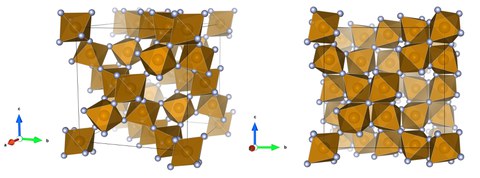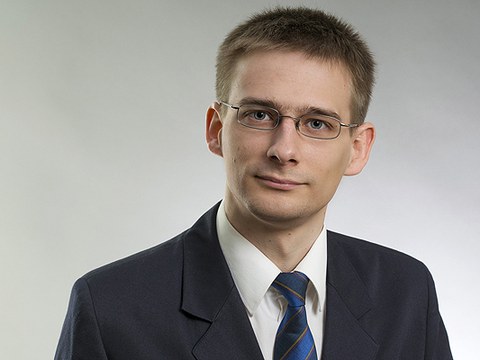Dr. rer. nat. S. A. Bräuninger
Supported by the SFB 1143.

Crystal structure (two views) of FeF3 (Fe is shown in brown and F is shown in grey)
Research Interests
The research focus is the nuclear-probe investigation of geometrically frustrated materials with exotic ground states and phase transitions. In this magnetic materials, the total energy cannot be minimized by minimizing the exchange interaction between all spin pairs simultaneously. A structure example consisting of edge-sharing tetrahedra is given by the FeF3 crystal structure above, the so called pyrochlores. FeF3 is a pyrochlore fluoride. The edges are antiferromagnetically coupled spins. The experimental properties of such kind of lattices generated by frustrated substructures are highly degenerate ground states, thus a zero temperature residual entropy and especially a suppression of magnetic long-range order is observed. The consequences are fascinating und unexpected ground states and phases depending on the conditions of the lattice, the electronic structures and perturbations:
- spin glass (Y2Mo2O7,Tb2Mo2O7)
- spin liquid (Tb2Ti2O7,Yb2Ti2O7)
- disordered spin ice in which magnetic dipoles fractionalized in monopoles (Ho2Ti2O7,Dy2Ti2O7)
- ordered spin ice (Tb2Sn2O7)
- effects like order-by-disorder (Er2Ti2O7)
to give selected examples for pyrochlore oxides. Nowadays, frustration is one of the most important research fields in magnetism and solid matter physics due to the exotic low temperature behavior and there are still a lot of open questions. For the interested student:
Geometrical Frustration: Moessner and Ramirez, Physics Today, 2006
Spin liquids in frustrated magnets, Balents, Nature 464, 199-208, 2010
Our investigation techniques are using a nuclear particle as a probe (e.g. the nucleus or a muon µ+):
- Muon spin relaxation, rotation and resonance Spin-polarized muons in condensed matter physics: Blundell, 2008
- NMR (Nuclear magnetic resonance)
- Mössbauer spectroscopy
These spectroscopy methods enable us to distinguish between different magnetic phases, to identify phase transitions in detail and to classify undiscovered states. To supplement our µSR studies, I am performing DFT calculations to calculate the muon site.
My PhD thesis Low-Energy Spin Dynamics in geometrically frustrated 3d-Magnets and Single-Ion Spin Systems is available and citable.

